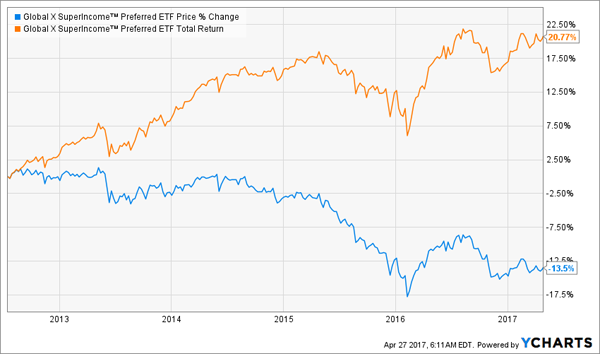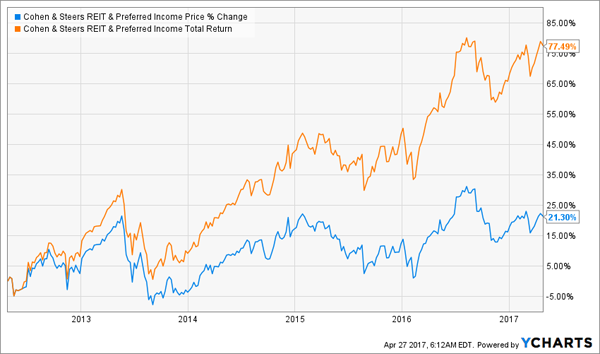The annual “sell in May and go away” period for stocks is nearly upon us, and many investors are worried about Wall Street starting to take profits from the market’s go-go run since November. Me? I’m looking for high-quality, high-yield dividend plays that you can buy in May – or June, or July, or whenever – and never sell.
Today, we’re going to discuss two 7%-plus yielders that fit any “no withdrawal” portfolio perfectly.
They are preferred stocks – wonderful “hybrids” that offer aspects of both stocks and bonds. Preferred stocks can trade on an exchange just like any common stock, but they trade around a par value and dole out a fixed regular payment just like a bond.
And the reason they’re called “preferred”? Because preferred stockholders actually have rights ahead of common stockholders in the event of financial distress – their dividends must be paid before the dividends on common stock, and a company can’t cut the dividends on preferred shares before it addresses regular shares.
Their biggest appeal, of course, is their excellent payouts. Many preferred shares yield in the 6%-7% range, making them a staple of most income- and retirement-geared portfolios.
But preferred stocks have another quality that often gets downplayed: They’re an excellent source of diversification. Douglas Baker, manager of Nuveen Preferred Securities Fund (NPSAX), “says they have relatively low correlations with other assets, including common stocks, high-yield bonds, and investment-grade bonds” in a recent interview with Barron’s.
However, not every preferred stock fund is a gem, which is why you must have a scrutinizing eye toward quality. Today, I’m going to show you a trio of preferred stock funds that yield 7%. All three look compelling at first glance, but one of them is actually a high-yield trap to avoid.
Global X SuperIncome Preferred ETF (SPFF)
Dividend Yield: 7.3%
The Global X SuperIncome Preferred ETF (SPFF) is part of Global X’s family of “Super” dividend-focused ETFs that include takes on the major geographic equity combinations, as well as REITs and alternative investments. And like the rest of those offerings, SPFF is one of the top yielders in its class – in fact, at more than 7%, SPFF is the highest-yielding ETF that deals solely in preferred stocks.
While that sounds like a good deal, it isn’t.
The SPFF’s dogmatic approach toward yield has turned it into a stark underperformer in an asset class that’s typically known for offering premium stability. Since inception in July 2012, the SPFF has declined 13.6%, compared to essentially flat trading for the iShares U.S. Preferred Stock ETF (PFF) and the VanEck Vectors Preferred Securities ex Financials ETF (PFXF). And unfortunately, those big dividends haven’t been able to make up for its poor movement, with the SPFF offering up roughly 20% once dividends are added in, versus 31% and 32% in total returns for the PFF and PFXF, respectively.
This yield trap is a siren song. Don’t get crushed against the rocks.
Global X’s SPFF Has Sagged Over Time

Flaherty & Crumrine Preferred Securities Income Fund (FFC)
Dividend Yield: 7.3%
A fund that has held up considerably better over the same time period is the Flaherty & Crumrine Preferred Securities Income Fund (FFC) – a closed-end fund that focuses on quality.
A quick refresher: Closed-end funds are very much like exchange-traded funds in that they hold a basket of securities and trade on an exchange. But unlike ETFs, CEFs go public with a fixed number of shares, so they typically trade in relatively tight ranges, at slight discounts or premiums to their net asset values.
At least 80% of FFC’s assets at any given time will be investment-grade preferred shares, not stretching for yield the same way SPFF does. However, the fund is able to deliver a similar yield thanks to CEFs’ ability to use leverage, typically by borrowing or issuing their own preferred shares.
FFC has roughly tripled the SPFF’s total returns since July 2012, at 72%, and currently yields well more than 7%. Meanwhile, it charges 0.89% in annual expenses.
Flaherty & Crumrine’s FFC Is a Much Better Double-Threat Play

Cohen & Steers REIT and Preferred Income Fund (RNP)
Dividend Yield: 7.5%
Lastly, I want to offer up the Cohen & Steers REIT and Preferred Income Fund (RNP), a secure 7%-plus yielder that represents a diversified way of investing in preferred stocks, and an interesting one at that.
When it comes to preferred stocks, funds will typically hold them in one of two ways – exclusively (like SPFF and FFC), or as part of a larger bundle of numerous high-yield assets (REITs, MLPs, BDCs). However, as the “REIT and Preferred Income” moniker suggests, RNP invests in just two things: real estate investment trusts, and preferred stocks. That means in addition to exposure to preferred shares, RNP also holds the likes of Simon Property Group (SPG), Prologis (PLD) and Equinix (EQIX).
The result is, as you would expect, a little bit more volatility than you get from pure preferred funds. But the returns more than compensate, with 77% in total returns since July 2012 – or more than 14% annually!
Expenses are currently 1.24% annually, and the fund trades at a generous discount to NAV of 12%.
REIT Exposure Super-Charges RNP’s Preferred Stock Holdings

The Retirement Portfolio You NEVER Have to Touch!
When you’re investing for retirement, you need the kinds of superstar yields that these three preferred stock funds deliver. The only issue is that most preferred stock funds don’t offer a lot of growth – a key attribute that many retirement investors ignore at their own peril.
The ultimate retirement portfolio is going to offer big, absolute yield, dividend growth potential and capital gains potential. And you’ll find these kinds of “triple threat” stocks in my “No Withdrawal” retirement portfolio.
These stocks weren’t easy to discover. In fact, I had to spend months researching hundreds of REITs, BDCs and other stocks looking for ultimate dividend plays that deliver everything we need to build a successful retirement portfolio … and I had to weed out numerous yield traps and value traps. But the effort was worth it, because it resulted in this can’t miss portfolio featuring:
- No-doubt 6%, 7% even 8% yields – and in a couple of cases, double-digit dividends!
- The potential for 7% to 15% in annual capital gains
- Robust dividend growth that will keep up with (and beat) inflation
All of these elements are critical for retirement holdings, because it allows you to live off income alone while actually growing your nest egg.
Most pundits that talk about so-called “retirement stocks” will point you in the direction of no-growth blue chips that yield 3%, maybe 4% if you’re lucky. But if you do the math, you won’t like what you see. Think about it: Even if you’ve saved up $500,000 for retirement, 4% annually is just $20,000 a year. You and I both know that even with Social Security tucked in there, that’s not a comfortable retirement.
The 8% average yield on my “No Withdrawal” portfolio – as well as the dividend growth that will yield to double-digit yields on cost over time – will ensure you have all the income you need to pay the bills (and then some). Meanwhile, the growth potential of these picks will help grow your nest egg in retirement, which is essential should you ever need to pay for a big one-time expense, whether it’s an emergency or just buying a vacation home.
This all-star portfolio features the very best of several high-income assets, from preferred stocks to REITs to closed-end funds and more. That means diversification and continued payouts regardless of how volatile or bearish the stock market becomes.
Don’t let mediocre yields from uninspired, lazy stock picks ruin the retirement you’ve worked so hard to build. You deserve substantial, regular dividend checks that will let you see the world and live in comfort for the rest of your post-career life.
Let me show you the path to a no-worry retirement. Click here and I’ll provide you with THREE special reports that show you the path to building a “No Withdrawal” portfolio. You’ll get the names, tickers, buy prices and full analysis of their wealth-building potential!
